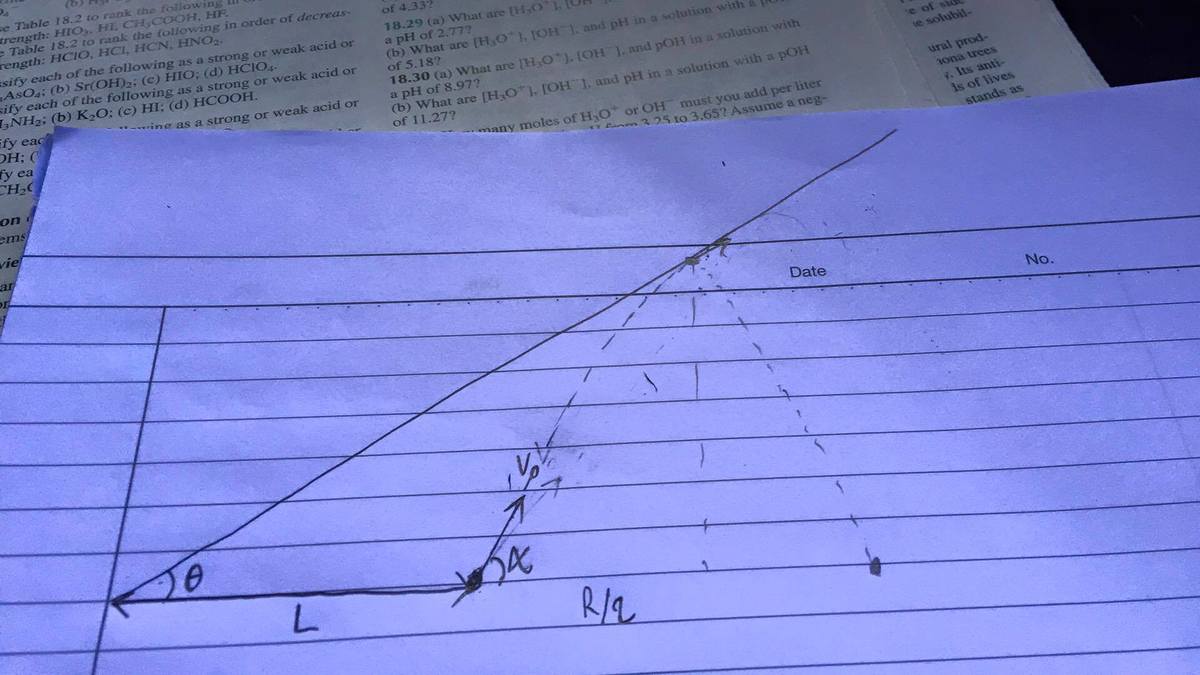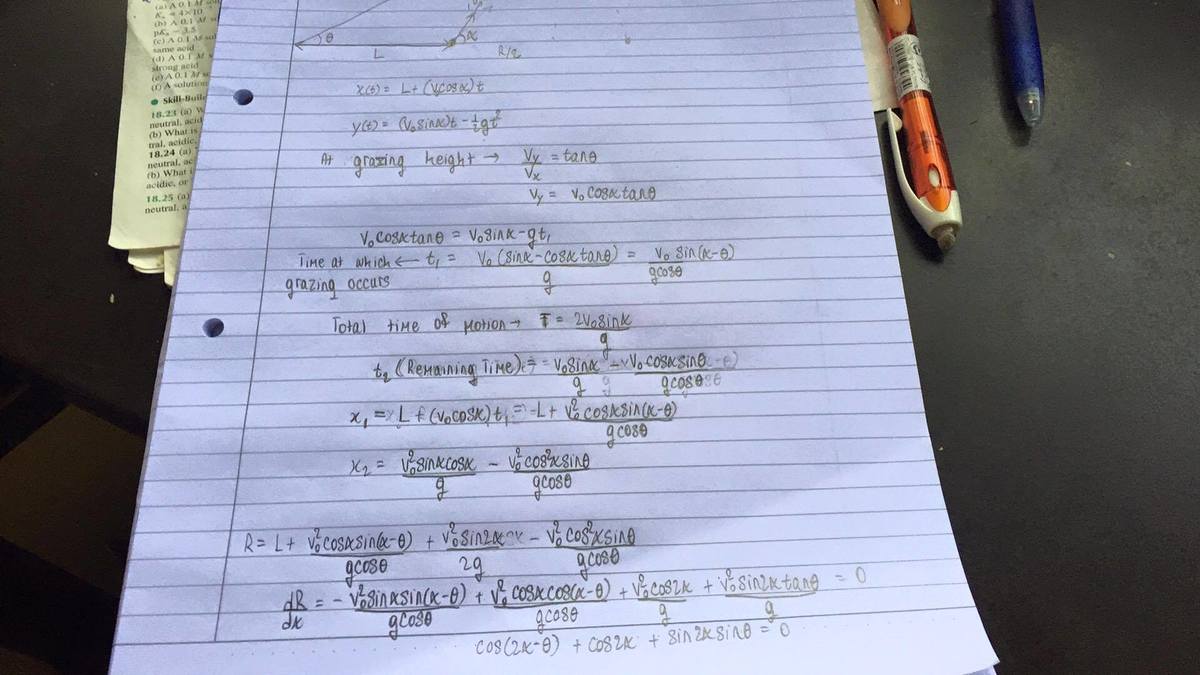Problem in Projectile Motion


So, I've actually attached the diagram illustrating the problem and my attempt at it. The problem goes like this; I have a cave which is inclined at theta. I have a ball inside the cave which is at a distance from the innermost portion of the cave. I kick the ball at a velocity and at an angle alpha to the horizontal. Find , in terms of , and , such that the range is maximized.
Could someone help me out, please? Having a bit of difficulty visualizing what this would look like.
No vote yet
1 vote
Easy Math Editor
This discussion board is a place to discuss our Daily Challenges and the math and science related to those challenges. Explanations are more than just a solution — they should explain the steps and thinking strategies that you used to obtain the solution. Comments should further the discussion of math and science.
When posting on Brilliant:
*italics*or_italics_**bold**or__bold__paragraph 1
paragraph 2
[example link](https://brilliant.org)> This is a quote# I indented these lines # 4 spaces, and now they show # up as a code block. print "hello world"\(...\)or\[...\]to ensure proper formatting.2 \times 32^{34}a_{i-1}\frac{2}{3}\sqrt{2}\sum_{i=1}^3\sin \theta\boxed{123}Comments
Bump. Could someone help me out lol
Like in many mathematical problems there are multiple ways to approach it. First lets summarize the assumptions made to simplify this problem:
Before diving into this particular problem, let's first have a look at the trajectory of the ball on itself.
In general the horizontal motion of a projectile is described by:
x(t)=x0+v0cos(α)t
And its vertical motion by:
y(t)=y0+v0sin(α)t−21gt2
where v0 (or just v for convenience) is the initial velocity vector at an angle α to the horizontal. We can neglect y0 because the ball is launched from the floor of the cave.
Notice you denoted x0 as L as being the horizontal distance from the innermost point of the cave to the point at which the ball was launched.
These expressions could be rewritten into a single expression describing the height y in terms horizontal distance x resulting in:
y(x)=(x−L)vcos(α)vsin(α)−2(vcos(α))2g(x−L)2
Simplified:
y(x)=(x−L)tan(α)−2(vcos(α))2g(x−L)2
The next step is to investigate the conditions at which the range is maximized. Therefore we need to look at the first two expressions again. When the ball hits the ground after its flight the height is equal to zero resulting in the following equation:
y(t)=vsin(α)t−21gt2=0
This gives us two solutions:
t=0
or
t=g2vsin(θ)
It can be easily seen that we were looking for the latter solution. Substituting this solution in the very first equation gives:
x−L=g2v2cos(α)sin(α)
Using the trigonometric identity:
sin(2α)=2sin(α)cos(α)
simplifies this to:
x−L=gv2sin(2α)
Notice that x−L is the horizontal distance traveled by the ball and it's maximized when the angle α equals 45∘.
Now we can dive into this particular problem. One way to approach this problem is by calculating the point at which the slope of the trajectory of the ball is the same as the slope of cave's ceiling. With this knowledge it's possible to calculate the horizontal shifting L of the trajectory needed to let the ball not hit the cave's ceiling. The height of the cave's ceiling at distance x:
yc(x)=xtan(θ)
And its slope:
dxdyc=tan(θ)
The height of the ball at distance x as found earlier:
yb(x)=xtan(α)−2(vcos(α))2gx2
Notice L=0 since the horizontal shifting is calculated later on.
And its slope:
dxdyb=tan(α)−(vcos(α))2gx
Equal slopes at:
tan(α)−(vcos(α))2gx=tan(θ)
Solving for x:
s=x=gcos(θ)v2cos(α)sin(α−θ)andg=0andv=0
Now it's known at what horizontal distance the slope of the trajectory will be equal to the slope of the cave's ceiling. The difference in height between the trajectory of the ball and the cave's ceiling can be converted into a horizontal distance that the trajectory needs to shift in order to let the ball not hit the ceiling. The horizontal shifting in terms of difference in height can be derived from the slope of the cave's ceiling:
L=tan(θ)∣yc(s)−yb(s)∣
This simplifies to:
L=gsin(2θ)v2sin2(α−θ))
Although it is not in explicit for α, I think this equation is quite elegant.
Here's a plot of a fitted trajectory with v=10ms−1,α=45∘,θ=15∘ and g=9.81ms−2:
And ofcourse to check:
L=9.81⋅sin(2⋅15)102⋅sin2(45−15)=5.097
For a maximized range α has to be as close as possible to 45∘. Notice that α would never be larger than 45∘ for a maximized range.
Thank you so much for your solution! Could you explain the last part of the solution though? Like, the part about the horizontal shifting. I didn't quite understand them properly.
Log in to reply
Imagine yourself that the ball was kicked from the innermost position of the cave ( L=0 ) . When the ball was kicked under an angle α larger than θ, the ball would bounce against the ceiling (red line in plot) . Since we don't want this to happen for a maximized range we shift the initial position where the ball was kicked so the ball wouldn't hit the ceiling (green line in plot).